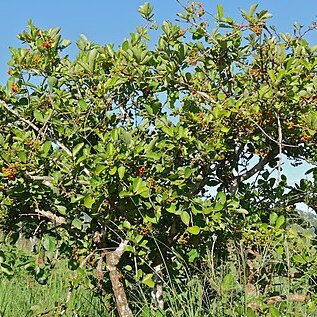Shrub or small tree, single or multistemmed, up to 5 m high, branches arching at top. Leaf blade occasionally elliptic, 45-95(-114) x 23-56(-75) mm, apex obtuse, cuspidate, margin entire, sometimes with one or more teeth, widely spaced, on either side of apex, veins prominently raised on lower surface, lower surface of leaf blade prominently veined, densely to sparsely hairy, setae appressed, setae on veins conspicuously orientated at right angles to veins, upper surface less hairy, setae often short and stiff at an angle to surface of leaf blade, giving a rough texture to blade; petiole 4-10 mm long, length of petiole : length of midrib = ±1 : 14. Inflorescence a branched cymose panicle, terminal on a young shoot or terminal on a short young shoot at apex of an abbreviated branchlet; axes and calyx clothed with setae and multicellular hairs. Calyx lobes narrowly triangular, 2-3 x 1 mm, apex acute. Corolla white; tube widely funnel-shaped, as long as calyx; lobes reflexed, usually as long as calyx or longer, apex obtuse, margin not ciliate. Fruit glabrous; pyrenes 3-1 mm long.
A shrub. It grows 3-4 m tall. It loses its leaves during the year. It has ashy white smooth branches. The bark is whitish or light grey. The leaves are oval and up to 6-11 cm long by 8 cm wide. They are blunt and with coarse teeth at the tip. They are dark green and rough on top and hairy below. The flowers are small and white. They have a smell. They occur on loose clusters at the ends of branches. The fruit are small and round and are green but turn orange when ripe. The fruit are 5-7 mm across. The fruit are edible.
Flowers hermaphrodite, 5-merous, a few times mixed with some 6-merous ones, short-lived, arranged in panicles often corymbiform, up to 10 x 14 cm., terminal on the shoots or often on very short lateral branches, either before or with the new leaves; peduncle, rhachis and branches sparsely to densely pubescent; bracts up to 5 mm. long, subulate, often only a few on the peduncle, sometimes also on the rhachis and on the branches; pedicels 0.2–1.5(2.5) mm. long, articulated near apex.
Petiole 0.3–1.0(1.7) cm. long, pubescent to subglabrous; leaf lamina 4–12 x 3–8 cm., circular to oblanceolate or obovate, rough above, pubescent beneath, rounded to shortly acuminate at apex or, sometimes, truncate and coarsely crenate-dentate, usually acute or cuneate, rarely obtuse at base, with margins entire to coarsely crenate-dentate to the upper part, papery to almost leathery, with 5–6 secondary nerves on each side of the midrib, net-veined.
Corolla rotate or subrotate, white; tube (1.5)2.0–3.0 mm. long, widely funnel-shaped, glabrous; lobes longer than the tube, (2.5)3.0–4.5 x 1.5–2.5 mm., oblong-ovate, obtuse or rounded at apex, ciliate, reflexed.
Small tree or shrub, up to 6 m high. Leaves scabrous above, pubescent below; venation reticulate, prominent below. Corolla lobes longer than tube, reflexed. Flowers white.
Calyx 2.0–3.0 mm. long, lobed to below middle, sometimes to near base, pubescent outside; lobes ovate to narrowly triangular, acute.
A shrub or sometimes a small tree up to 6(8) m. high, deciduous; branches pubescent to subglabrous, glabrescent and greyish.
Ovary c. 1 mm. long, glabrous; style 3–5 mm. long, divided 1/52/5 very rarely half-way down; stigmas small, subumbilicate.
Stamens about as long as the corolla lobes; anthers 1.5–1.8 mm. long, oblong; filaments 2.5–4.0(4.5) mm. long, slender.
Fruit c. 5 x 6 x 5 mm., subglobose, glabrous; pyrenes 4, with the out surface irregularly foveate.



